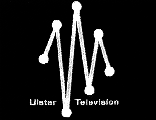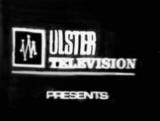

 Ulster
Ulster
"UTV needs more people, more equipment, more space and clearly a
bigger programme budget"
Belfast Evening Telegraph, January 1960
"The area also has its own set of sharp and often bitter
political tensions"
Pilkington Committee
Ulster Television History
Initiation
Enquiries had been received from as early as 1956, but over 90% of
the UK's population had already been covered by an ITV station by the
time that Northern Ireland came to the top of the ITA list, at more
or less the same time as consideration was being given to a
commercial station in the Republic of Ireland (an idea in the end
rejected in favour of a public authority, now RTE).
The franchise was advertised on 2 September, to broadcast from Black
Mountain, to the west of Belfast. Five local groups were formed, with
the task of producing their application in just over a month. Two
finally emerged: one chaired by the Duke of Abercorn, with the main
support coming from the Belfast Evening Telegraph and Northern Whig
newspapers; the other led by the Earl of Antrim, with the involvement
of Sir Laurence Olivier, Betty Box and the Newsletter group.
There were also applications made by Associated
Rediffusion and Granada, hopeful
as ever.
ITA plays matchmaker
The ITA was keen to bring the two local consortia together, but sounding
the two parties out made it clear that this was not a possibility.
After interviews on 4 November 1958 the Antrim group was preferred,
possibly because they offered to make 25% of its shareholding
available to others. Of the initial capital issued only 4% was owned
by Catholic bodies, and with the ITA's encouragement this was
increased to 17.5% to 28 new investors, including the newspaper the Irish News.
Money jitters
Ulster Television Limited, as the group was now called, recognised
that they were short of practical television experience, and were
facing a tough financial position, with prospect initially of serving
only 100,000 homes, although there was the longer term promise by
the ITA to open a relay in western areas beyond the reach of Black Mountain.
Initially they presented a plan of programmes with plenty of promises
which did not match up to their single studio facility, which had
neither recording equipment, nor any outside broadcast capability.
Not for the first time a company tried to soften the position taken
during the franchise application. They presented a plan where
initially they would limit local production to 20 minutes per day,
without a local news bulletin, and that they would not carry some of
the more 'serious' programmes from the network, substituting popular
programmes made previously. These plans were sent to the ITA not by
UTV itself, but ABC, with whom UTV had signed
an affiliation agreement. As well as providing general support, ABC were to sell UTV's advertising for some
years, and supervised their studios at Havelock House, a former
clothing warehouse.
On the air
The first person on Ulster television was
Sir Laurence Olivier, in
the unlikely guise as the host of a Hallowe'en party. A speech was
given by Lord Wakehurst, followed by six schoolboys from Belfast and
the singer Richard Hayward. After a brief look forward to new
programmes they joined the network for Robin Hood, and had no further
local content apart from commercials until Sir Laurence Olivier
returned to read the epilogue. The only recorded complaints on
opening night related to poor reception experienced in Dublin.
Apart from a single programme the following day showing traditional
country crafts local programming was confined to the Runabout
magazine until the following January, when local output was raised to
four hours, and later in that year to the originally promised six.
The finances improve
The audience share UTV gained was high; for Roundabout it regularly
reached 80%. In the first six months all the previous expenditure had
been paid off, and profits were already being made. The number of
homes had shot up to 160,000 at the time of the first birthday, with
100,000 of these buying the UTV programme guide TV Post. By
1962 they could afford to buy an Ampex VTR and equip a studio twice
the size of their existing one, and replace Roundabout with a more
newsy programme. Finally they reached the west of their region (and
more of the Republic) when the Strabane transmitter was opened.
Transmitters
VHF
Black Mountain 9H 31/10/59
Strabane 8V 18/02/63
Ballycastle 13H 06/07/70
UHF(Main)
Divis 24H 14/09/70
Limavady 59H 01/12/75
Brougher Mountain 25H 1978










